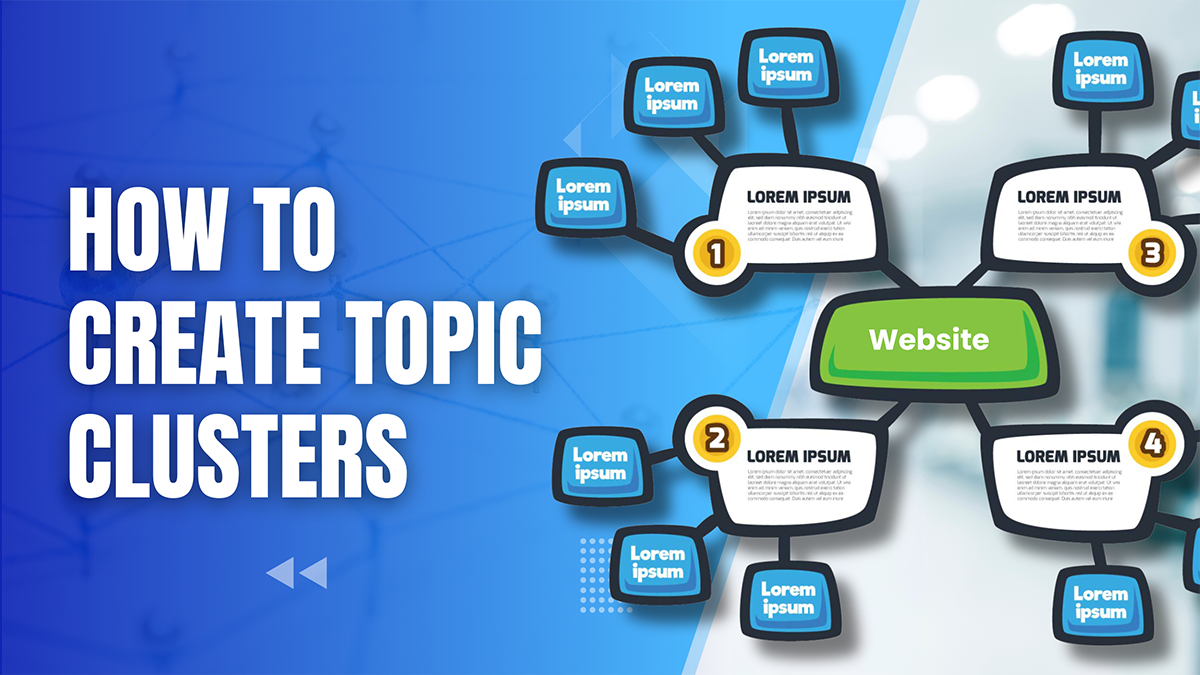In these times content is king, but how can you make sure people find and love your content? This transformative journey begins with understanding and harnessing the power of topic clusters, a methodological approach that synergizes your content, making it more discoverable, engaging, and, ultimately, impactful. By structuring your content around pivotal themes, you create a web of information that’s not just user-friendly but also favored by search engines, elevating your SEO to new zeniths.
Think of your website as a library. Right now, it might be a bit messy, with books (your articles and posts) scattered everywhere. Topic clusters help you organize this library so that everything is easy to find. Not only does this make your visitors happy, but it also shows search engines that you’re a reliable source of information, which can bump your website up in search results.
So, why should you care about How to Create Topic Clusters? Because it’s a straightforward way to get more people to visit your website and enjoy what you offer. By the end of this guide, you’ll know how to group your content smartly, making your website a go-to destination for your audience. Let’s dive in and make your content shine!
What Are Topic Clusters?
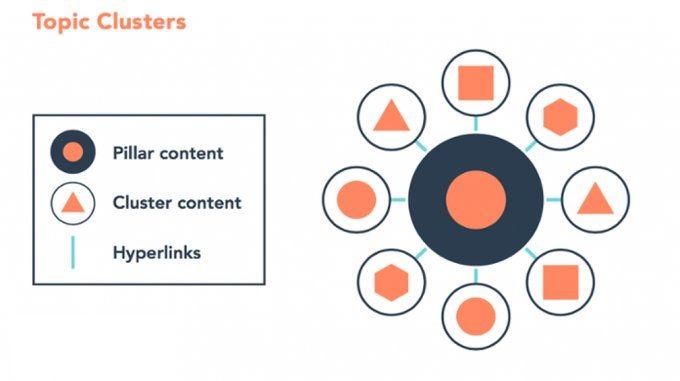
Topic clusters are interconnected web pages that link related content on your website, forming a cohesive structure. Known by various names such as pillar pages, hub-and-spoke models, or content hubs, these clusters facilitate easy navigation for your audience, enabling them to discover information related to their initial search queries within your site.
SEO service providers guide clients in organizing topic clusters on their websites to enhance SEO by strategically grouping related content, which improves website structure, user experience, and search engine visibility.
The breadth of a topic cluster, in terms of subtopics and content pieces, varies depending on your offerings, the content you create, and your audience’s informational needs. A topic cluster typically consists of three main elements:
Pillar Content
At the heart of your content marketing strategy lies the pillar content, which succinctly articulates your business offerings and their relevance to your target audience and clients. In the context of a topic cluster, pillar content serves as the central hub, around which all related content orbits.
Pillar content is characterized by its depth and breadth, covering the essential facets of a topic comprehensively. It addresses the fundamental questions of who, what, when, where, why, and how, providing a solid foundation for the cluster. The creation of a topic cluster begins with identifying the core subject your blog or brand will focus on, which forms the nucleus of your cluster. This central topic should be broad enough to encompass various subtopics under its umbrella.
Moreover, the pillar piece should delve into an in-depth discussion of the chosen topic, typically presented in a long-form format. To ensure clarity and organization, it’s advisable to use subheadings and embed links to related content within the piece, enhancing its value and navigability.
Cluster Content
Cluster content comprises individual articles that focus on specific facets of the main topic outlined in your pillar content. These pieces may vary in length, but their defining characteristic is their detailed exploration of a particular segment of the broader subject. Often presented in the form of concise blog posts or various content types, cluster content serves as the building blocks that stem from and enrich the central pillar post.
Each piece within a content cluster delves deeper into a niche aspect of the main topic, creating a web of related information that all points back to the central pillar content. The primary aim of these clusters is to meet search intent with greater precision, offering answers and insights that further refine the audience’s search journey.
Hyperlinks
Integrating hyperlinks within topic clusters is pivotal for knitting together the pillar content and its associated clusters, facilitating seamless navigation for users. Hyperlinks are instrumental in forging these vital connections, enhancing the coherence and utility of the content network. While the pursuit of external backlinks is often highlighted for its SEO benefits, the power of internal linking within topic clusters should not be underestimated.
Strategic internal linking within topic clusters aids users in discovering related content effortlessly and enables search engines to better understand the relational structure of your site’s content. A rich array of interconnected articles on a specific subject signals to search engines the presence of authoritative content on your site, potentially boosting your domain’s authority. This interconnectedness not only enriches the user experience by encouraging deeper exploration of your site but also strengthens the site’s SEO foundation.
Why Are Topic Clusters Important for SEO?
With the introduction of RankBrain in 2015, Google significantly refined its algorithm to prioritize content that aligns with search intent, transitioning the focus from mere keyword density to the richness and relevance of information. In the realm of Google’s algorithm, the emphasis on content quality supersedes the traditional reliance on keyword density, with a multitude of factors, including the clarity of search intent, playing a role in determining content rankings on the search engine results pages (SERPs).
Research suggests that content that thoroughly covers a specific topic tends to achieve higher rankings, positioning your brand as a thought leader in your industry. Topic clusters come to the forefront in this context, as they embody Google’s mission to furnish users with pertinent and substantive content.
By methodically organizing your content into topic clusters, you not only streamline your content strategy but also cater to Google’s preference for delivering valuable, comprehensive content to users. This methodical approach, coupled with RankBrain’s influence and the holistic nature of topic clusters, can expedite and amplify your SEO impact.
Also Read: Informational Content: The Key to Engagement (How to Write Them)
What Are the Benefits of Topic Clusters for SEO?
Integrating topic clusters into your content strategy can significantly bolster your SEO initiatives. Let’s explore the manifold benefits this approach offers:
- Enhances Long-Term Google Ranking: By organizing your content into interconnected topic clusters, you weave a web of cohesive information. This structure is recognized by search engines, leading to a gradual and sustained enhancement of your site’s position in search results. Google values the coherence and depth of your content, rewarding it with higher visibility.
- Improves User Experience Significantly: Presenting related content in clusters enhances the user journey on your website. Visitors encountering a wealth of interconnected articles on a subject are more inclined to delve deeper and spend more time on your site. This increased engagement not only improves user satisfaction but can also boost conversion rates and interactions.
- Establishes Trust with Your Readers: Demonstrating your expertise through comprehensive topic clusters builds credibility with your audience. Users come to regard your site as a trusted resource for in-depth information, solidifying your reputation as an authoritative source.
- Builds Topical Relevancy: Organizing content into clusters underlines your site’s relevance to particular topics or themes. This relevance not only meets user search intent but is also favored by search engine algorithms, thereby increasing your content’s visibility.
- Enables Ranking for More Competitive Terms: With established authority in specific topic areas, your site is better equipped to rank for competitive keywords. The extensive and detailed nature of your content signals to search engines that your pages are worthy contenders for top spots in search results for high-demand terms.
Topic clusters transform the content organization into a strategic tool that enhances search rankings, user experience, reader trust, topical relevance, and competitiveness for key search terms. These collective benefits significantly uplift your SEO strategy.
How to Create Topic Clusters
Step 1: Evaluate Your Existing Content
Begin with a thorough examination of your current content. This review is crucial even if you’re considering new topic clusters, as it provides insight into the existing structure of your content. Use this as a foundation for developing new clusters.
Systematically review all your articles to identify recurring themes. Organize related content into groups using a spreadsheet or list, making it easier to visualize connections. During this audit, be mindful of duplicate content, which can adversely affect your SEO efforts.
Duplicate articles compete for the same keywords and search engine ranking, leading to unnecessary internal competition. Use this opportunity to optimize or refresh any content that may be outdated or underperforming, ensuring it aligns with your topic cluster strategy.
Step 2: Choose Your Core Topic
Initiating a topic cluster strategy begins with selecting a central theme you aim to be recognized for on search engines like Google. Opt for a broad subject that garners substantial search volume, such as “car insurance” or “best credit cards.” It’s important to note, however, that such topics are highly competitive due to their prevalent search popularity.
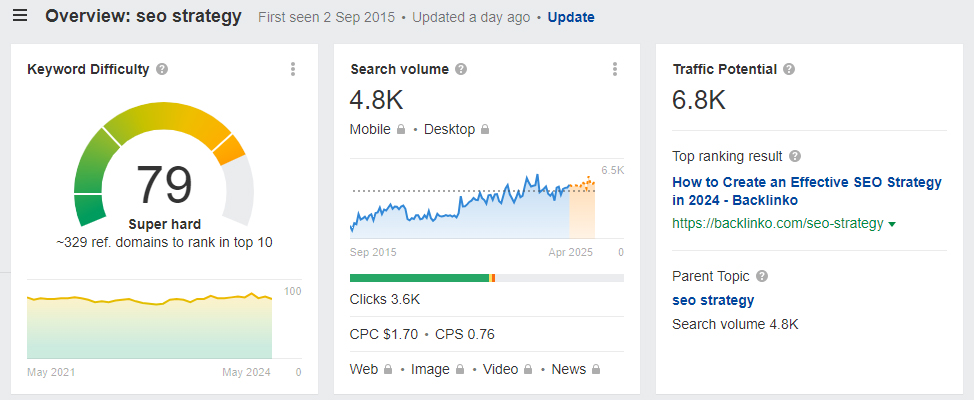
To unearth your core topic, engage in brainstorming sessions or leverage SEO keyword research tools to discover pertinent terms and long-tail keywords that will guide your content direction. Consider using advanced tools or platforms like ChatGPT for an in-depth exploration of your chosen subject.
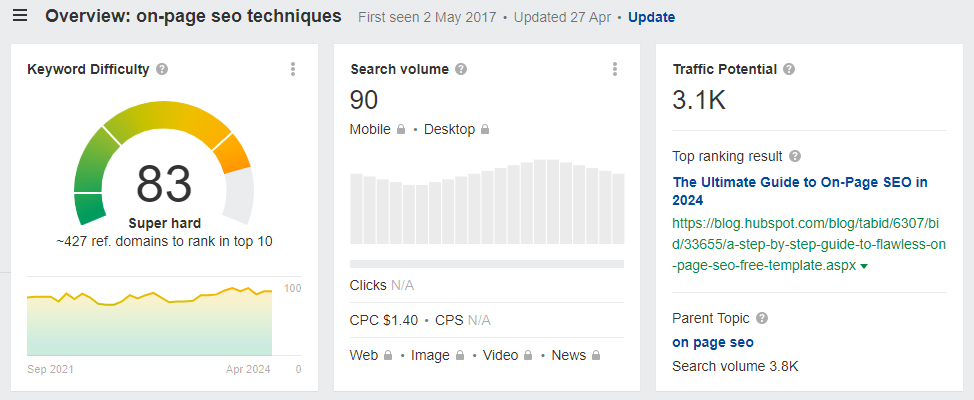
Once your main topic is decided, the next step involves identifying both primary and secondary keywords related to each cluster. Primary keywords should revolve around your central theme, while secondary keywords can delve into more nuanced aspects. For instance, if “SEO Strategy” is your main keyword, your research should extend to related long-tail phrases such as “on-page SEO techniques,” “keyword research strategies,” or “backlink acquisition methods.”
The goal is not just to compete for the highly contested main keywords but also to achieve rankings for the associated, less competitive terms discovered during your research. This approach ensures a steady stream of organic traffic to your site.
Step 3: Creating Pillar Content
The creation of pillar content is pivotal in deeply exploring and presenting your main topic. This comprehensive content serves as the foundation of your topic cluster, drawing in and engaging your audience. Follow these guidelines to elevate the impact and quality of your pillar content:
- Understand Search Intent and User Needs: Thoroughly research your audience’s queries and expectations related to the topic. Aim to resolve their inquiries, offer actionable advice, and present insightful information within your pillar content.
- Use Engaging and Informative Headings and Subheadings: Organize your content into clear, logical sections underpinned by engaging headings and subheadings. This structure not only enhances readability but also allows users to easily find the information they seek.
- Incorporate Multimedia Elements: Enrich your content with diverse multimedia elements such as images, videos, and infographics. These components add visual interest, break up text, and engage readers more profoundly.
- Ensure High-Quality and Well-Researched Content: Pillar content demands rigorous research and a display of expertise. Ensure the information is accurate, current, and surpasses your audience’s expectations, thereby establishing your authority in the domain.
- Optimize for SEO: Carefully format your content, including headings, meta tags, and URLs, for SEO. Use internal and external links wisely to offer further reading and improve search visibility. Integrate primary and secondary keywords throughout the text to enhance relevance and search ranking.
For identifying relevant terms and refining your content, consider tools like Surfer SEO. This tool analyzes top-ranking content to identify key terms used by your competitors, providing insights to optimize your own content and improve search rankings.
Also Read: The Art of SEO Content Silos Architecture
Step 4: Creating Cluster Content
After crafting your pillar content, the subsequent step involves creating cluster content that enriches and supports your main topic. This content should delve into the specific subtopics and nuances that are intricately linked to your central theme. Generating ideas for this content can stem from brainstorming sessions centered on related subjects or by investigating common queries associated with your main topic.
Utilizing tools like ChatGPT can be immensely helpful in generating a wide array of relevant topics. Producing informative, well-optimized articles within your cluster is key to reinforcing the coherence and connectivity of your entire topic cluster.
Organizing this related content beneath your pillar article simplifies navigation for users, which in turn can enhance your SEO ranking. This systematic approach allows users to effortlessly delve into different aspects of the topic, while search engines acknowledge the comprehensive and interconnected nature of your content, elevating its prominence and reach.
Step 5: Linking and Organizing the Cluster
Establishing a coherent network of links is crucial in forging a robust topic cluster. The strength of your cluster hinges on the strategic interlinking of cluster content back to the pillar article, which serves to bolster both SEO efficacy and user navigability. Employing descriptive anchor texts for these links is advisable, as it underscores the relevance and encourages users to explore interconnected articles.
This meticulous organization transforms your site into a respected repository of knowledge on a particular subject, consequently elevating your Google search ranking. Furthermore, this structured presentation of content is likely to be recognized and valued by authoritative sites, enhancing your site’s visibility. Achieving a prominent spot on the first page of search results becomes more feasible, affirming your website’s status as a trusted and authoritative information source in your field.
Step 6: Check Other SEO Factors
Beyond keyword research and backlinking, a successful SEO strategy encompasses a spectrum of elements that must synergize to elevate your content’s quality and visibility. This includes not only writing and technical aspects but also on-page optimization and off-site SEO efforts, all of which are integral to the overall effectiveness of your SEO.
In the context of internal linking and content structuring, it’s crucial to adhere to established SEO best practices. Enhance the readability of your content with well-organized headings and bullet points, and employ clear, concise language. Additionally, distributing your content across relevant platforms can further amplify your topic clusters’ reach and impact.
Content that is accessible, engaging, and easy to navigate tends to retain users longer, encouraging interactions that signal to search engines the content’s relevance and value. If your content incorporates calls to action, its effectiveness is contingent upon users’ ability to easily access and comprehend your content.
Step 7: Analyzing Data for Success Monitoring and Measurement
Following the implementation of your topic clusters, the next imperative step is to vigilantly monitor your Key Performance Indicators (KPIs) to evaluate the efficacy of your content strategy. Utilize tools like Google Analytics to track your progress, paying close attention to metrics such as organic traffic, search rankings, and user engagement to gauge the impact of your topic clusters.
Assessing the success of your topic clusters necessitates a methodical approach to data analysis. Begin by establishing a baseline before the introduction of topic clusters to serve as a point of comparison. This benchmark enables you to measure the tangible effects of your content organization efforts. Continuously monitor these metrics over time to observe trends and shifts in performance.
The metrics you choose to focus on might differ based on your specific objectives. While some organizations may emphasize bounce rates, others might prioritize metrics such as the average time spent on the site. Regardless of the chosen metrics, they should offer valuable insights into the performance of your topic clusters and highlight areas that may require adjustments or enhancements.
Topic Cluster Examples
Adopting topic clusters in SEO involves varied strategies. Here, we delve into specific examples of topic clusters, illustrating how each can be effectively executed to bolster subject matter expertise and enhance online visibility.
Example 1: Podia’s Comprehensive Guide on Creating and Selling Profitable Online Courses
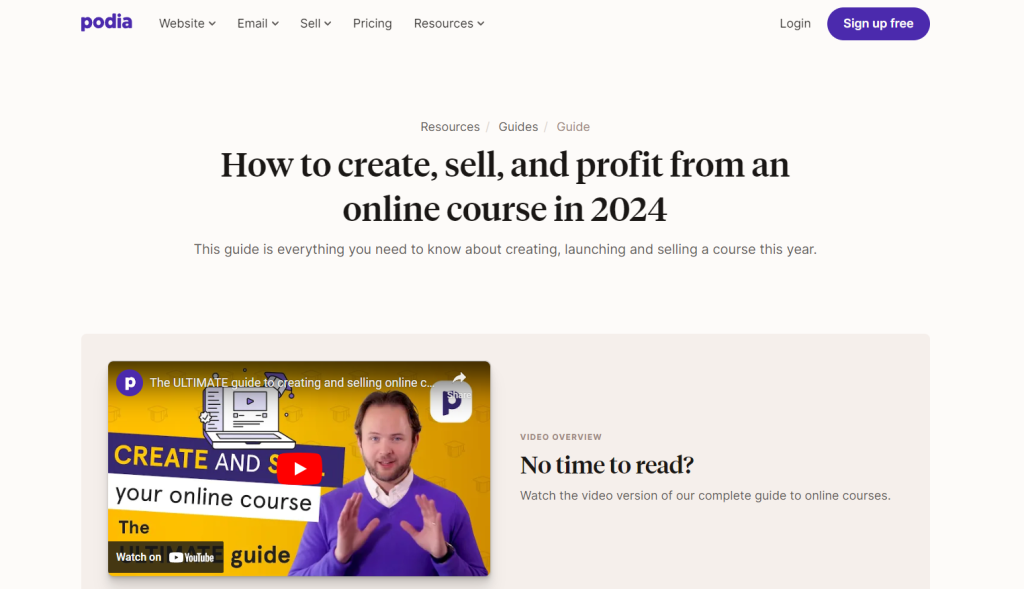
Podia has crafted a detailed guide centered on the creation, marketing, and monetization of online courses, a topic of significant interest in 2024. This guide is meticulously organized in a topic cluster format, with the main hub located at:
https://www.podia.com/how-to-create-sell-profitable-online-course.
This central page links to eight subsidiary chapters, each addressing a facet of online course creation and marketing, thereby providing a comprehensive overview of the topic.
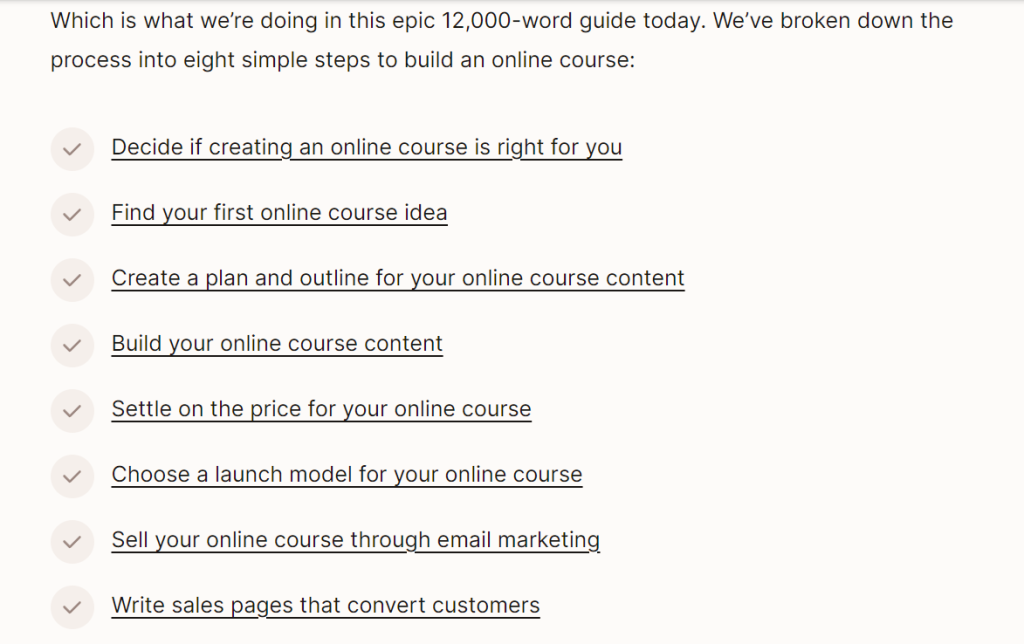
This setup exemplifies a well-executed topic cluster, where a main hub page directs readers to related subpages, enriching their understanding of the subject. The content within this cluster is predominantly evergreen, necessitating only occasional updates to remain current and relevant.
Podia’s guide exemplifies how to divide a complex, long-form topic into manageable, interconnected sections. This not only showcases Podia’s deep knowledge in the field but also offers a valuable, lasting resource for those interested in the intricacies of online course creation and monetization.
Example 2: HootSuite’s Social Media Guides
HootSuite, renowned for its social media management tools, employs a strategic content marketing approach, organizing its blog content into distinct topic clusters, especially for comprehensive social media platform guides.
A standout instance is their in-depth guide to Facebook Marketing in 2023, distinguished by its depth and the inclusion of over 25 internal links to HootSuite’s other Facebook-related articles. These cover a range of topics from Facebook Reels and Business Manager to Facebook Ads, and even extend to guides on related subjects like influencer marketing.
The interconnectivity of HootSuite’s content is particularly notable, with numerous links pointing back to the Facebook Ad guide, emphasizing the importance of maintaining up-to-date links as the content cluster expands.

Additionally, the consistently high quality of HootSuite’s articles ensures that each piece not only supports the cluster but is also robust enough to stand alone and achieve good search rankings. This dedication to producing in-depth, high-quality content plays a crucial role in the success of HootSuite’s topic cluster strategy.
Example 3: Atlassian’s Agile Coach Guide
Atlassian, renowned for its suite of B2B products, excels in aiding customers to adopt agile methodologies and comprehensive management practices. A cornerstone of their strategy is the creation of authoritative content that spans the breadth of agile practices.
Central to this approach is a meticulously crafted topic cluster, anchored by an in-depth pillar page on Agile. This page serves as the foundational resource for users seeking a thorough understanding of agile principles.
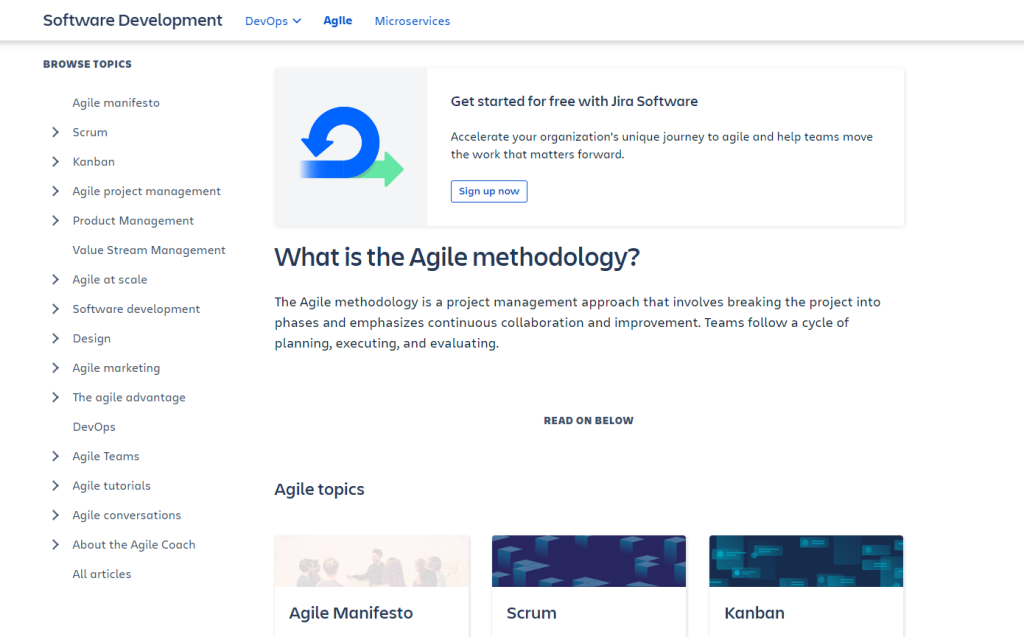
Atlassian’s content thoughtfully delves into the role of an agile coach and elucidates key agile concepts, ensuring precision and clarity. Each page within the cluster is dedicated to a specific aspect of agile, like the detailed exposition on Scrum as a framework facilitating team organization and task management.
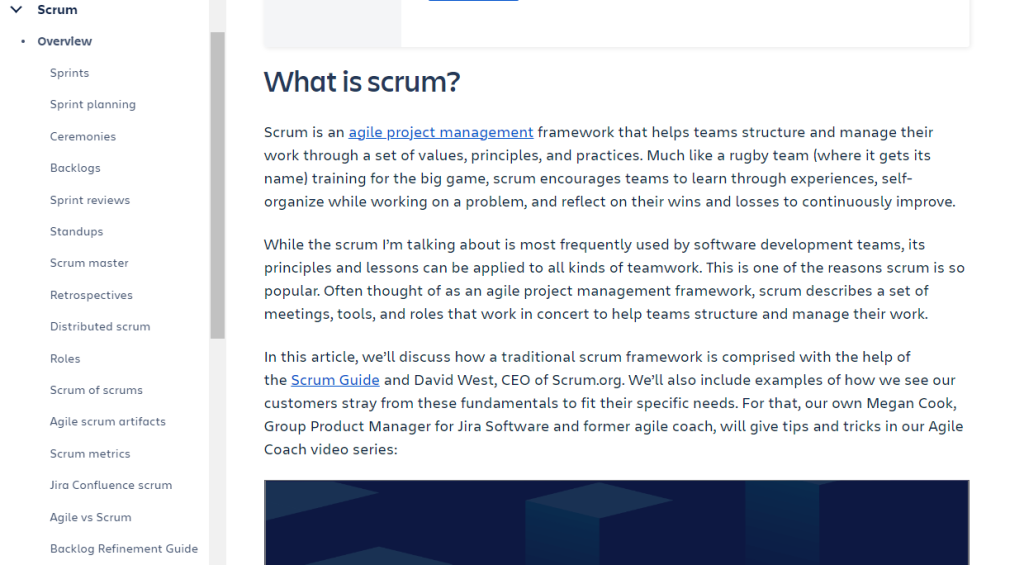
A user-friendly sidebar within the guide enhances navigation by linking to subtopic pages and dynamically suggesting further reading, enriching the user experience. Strategic interlinking within the content ensures a cohesive and comprehensive knowledge base.
The depth of Atlassian’s topic cluster is evident in its exploration of agile subtopics, such as Agile sprint reviews. Here, practical guidance is offered to optimize sprint reviews, demonstrating Atlassian’s commitment to actionable insights.
User navigation is further streamlined with the implementation of breadcrumbs on tertiary pages, enabling easy movement between related content and back to the pillar page. An “Up Next” banner at the bottom of pages thoughtfully guides users through the content journey, facilitating engagement with related topics.
Also Read: The Complete Guide to Blog SEO!
How Do Topic Clusters Work?
Topic clusters are a strategic approach to content organization and internal linking, with several key components:
- Semantic Search: Modern search engines aim to comprehend the intent behind queries, focusing on the contextual meaning rather than just matching keywords.
- Topical Authority: Gained through the consistent publication of in-depth content on a subject, establishing your site as a go-to resource.
- Topic Entities: Distinct concepts or objects recognized by search engines, based on user search terms, that help in identifying the unique subject matter.
- Search Queries: The actual words or phrases users input into search engines, which are critical for understanding user intent.
- Keywords: Specific words that summarize the main content of a page, aiding search engines in identifying the primary topics of discussion.
- Google Knowledge Graph: A database used by Google to enhance search results with relevant, contextually rich information displayed alongside traditional results.
- Content Pillars: Comprehensive content pieces that cover a broad topic in-depth, serving as the foundation for a cluster of related content.
- Topic Mapping: Visual diagrams that illustrate the relationships between various concepts, aiding in content organization and strategy.
- Content Hierarchy & Website Structure: The strategic arrangement of information on a website, prioritizing the most critical content for immediate visibility.
- Interlinking: The practice of embedding hyperlinks within content that lead to other related articles on the same website, improving navigation and reinforcing content coherence.
Conclusion
Incorporating topic clusters into your SEO and content strategy can profoundly enhance your website’s visibility and drive organic traffic. By diligently applying the outlined steps, you can craft a cohesive topic cluster that serves as a cornerstone for your digital marketing efforts.
Key to this process is conducting extensive keyword research, crafting compelling pillar content, and creating detailed cluster articles. Implementing a strategic linking approach and continuously monitoring your strategy’s performance will maximize the effectiveness of your topic clusters.
Staying abreast of algorithm updates and adapting your strategy to these changes is imperative for maintaining and enhancing your SEO success. If you’ve found these insights valuable, consider sharing them on social media and engaging with any further questions or discussions in the comments section.
FAQs
How many pages should you include in a cluster?
The ideal number of pages in a topic cluster isn’t set in stone. It varies greatly depending on the depth and breadth of the subject matter. While some clusters might be concise, with just a handful of pages, others could expand into the hundreds, depending on the complexity and scope of the topic. Aim for a balance that thoroughly covers the subject without diluting your content’s impact or causing keyword cannibalization, where similar subtopics compete against each other for ranking.
How do I choose a pillar topic for my cluster?
Your pillar topic should be a broad subject area that is central to your business or field of expertise, allowing for the development of various subtopics. Factors to consider include the topic’s search volume, its relevance to your target audience, and your own knowledge and resources to cover the topic comprehensively.
How should I structure my topic cluster content?
Organize your topic cluster with a central pillar page that broadly addresses the main topic, surrounded by individual pieces of content for each subtopic. These should be interlinked with the pillar page and amongst themselves where relevant, facilitating easy navigation for both users and search engines through the interconnected content.
What are subtopics, and how do I choose them for a topic cluster?
Subtopics are detailed facets or inquiries related to your main pillar topic. Identify subtopics that delve deeper into the subject, answer specific audience questions, or explore niche areas within the broader topic. Effective keyword research and a deep understanding of your audience’s interests and pain points are crucial in selecting the most relevant and engaging subtopics.
